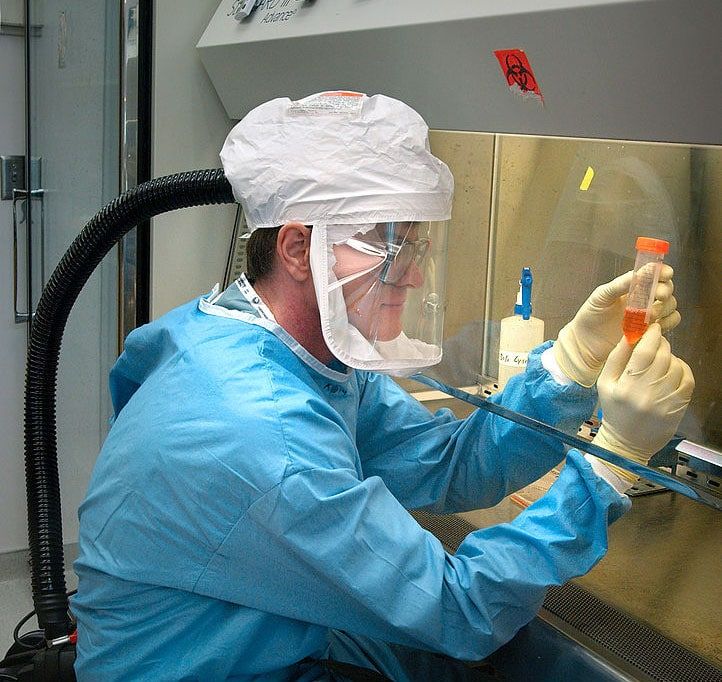Human error in high-biocontainment labs: a likely pandemic threat
By Lynn Klotz | February 25, 2019
 A CDC staff microbiologist examines reconstructed 1918 Pandemic Influenza Virus at a Biosafety Level 3-enhanced lab. Photo by James Gathany / CDC
A CDC staff microbiologist examines reconstructed 1918 Pandemic Influenza Virus at a Biosafety Level 3-enhanced lab. Photo by James Gathany / CDC
Incidents causing potential exposures to pathogens occur frequently in the high security laboratories often known by their acronyms, BSL3 (Biosafety Level 3) and BSL4. Lab incidents that lead to undetected or unreported laboratory-acquired infections can lead to the release of a disease into the community outside the lab; lab workers with such infections will leave work carrying the pathogen with them. If the agent involved were a potential pandemic pathogen, such a community release could lead to a worldwide pandemic with many fatalities. Of greatest concern is a release of a lab-created, mammalian-airborne-transmissible, highly pathogenic avian influenza virus, such as the airborne-transmissible H5N1 viruses created in the laboratories of Ron Fouchier in the Netherlands and Yoshihiro Kawaoka In Madison Wisconsin.
Such releases are fairly likely over time, as there are at least 14 labs (mostly in Asia) now carrying out this research. Whatever release probability the world is gambling with, it is clearly far too high a risk to human lives. Mammal-transmissible bird flu research poses a real danger of a worldwide pandemic that could kill human beings on a vast scale.
Human error is the main cause of potential exposures of lab workers to pathogens. Statistical data from two sources show that human error was the cause of, according to my research, 67 percent and 79.3 percent of incidents leading to potential exposures in BSL3 labs. These percentages come from analysis of years of incident data from the Federal Select Agent Program (FSAP) and from the National Institutes of Health (NIH). (Details may be found in the Supplementary Material document.)
Understanding human error is important to calculating the probability that a pathogen will be released from a lab into the surrounding community, the first step in calculating the likelihood of a pandemic. A key observation is that human error in the lab is mostly independent of pathogen type and biosafety level. Analyzing the likelihood of release from laboratories researching less virulent or transmissible pathogens therefore can serve as a reasonable surrogate for how potential pandemic pathogens are handled. (We are forced to deal with surrogate data because, thank goodness, there are little data on the release of potentially pandemic agents.) Put another way, surrogate data allows us to determine with confidence the probability of release of a potentially pandemic pathogen into the community. In a 2015 publication, Fouchier describes the careful design of his BSL3+ laboratory in Rotterdam and its standard operating procedures, which he contends should increase biosafety and reduce human error. Most of Fouchier’s discussion, however, addresses mechanical systems in the laboratory.
But the high percentage of human error reported here calls into question claims that state-of-the-art design of BSL3, BSL3+ (augmented BSL3), and BSL4 labs will prevent the release of dangerous pathogens. How much lab-worker training might reduce human error and undetected or unreported laboratory acquired infections remains an open question. Given the many ways by which human error can occur, it is doubtful that Fouchier’s human-error-prevention measures can eliminate release of airborne-transmissible avian flu into the community through undetected or unreported lab infections.
Human-error incident data. In its 2016 study for the NIH, “Risk and Benefit Analysis of Gain of Function Research,” Gryphon Scientific looked to the transportation, chemical, and nuclear sectors to define types of human error and their probabilities. As Gryphon summarized in its findings, the three types of human error are skill-based (errors involving motor skills involving little thought), rule-based (errors in following instructions or set procedures accidentally or purposely), and knowledge-based (errors stemming from a lack of knowledge or a wrong judgment call based on lack of experience).
Gryphon claimed that “no comprehensive Human Reliability Analysis (HRA) study has yet been completed for a biological laboratory… . This lack of data required finding suitable proxies for accidents in other fields.”
But mandatory incident reporting to FSAP and NIH actually does provide sufficient data to quantify human error in BSL3 biocontainment labs.
Federal Select Agent Program incident data. FSAP incident data were collected from summary reports to Congress for the years 2009 through 2015.
Three of the seven FSAP incident categories involve skill-based errors: 1) needle sticks and other through the skin exposures from sharp objects, 2) dropped containers or spills/splashes of liquids containing pathogens, and 3) bites or scratches from infected animals. Some skill errors, such as spills and needle sticks could be reduced with simple fixes (see below).
The rule-based and knowledge-based incident categories are: 4) pathogens manipulated outside of a biosafety cabinet or other equipment designed to protect exposures to infectious aerosols; 5) potential exposures resulting from non-adherence to safety procedures or deviations from lab standard operating procedures, and 6) failure or problem with personal protective equipment–a mix of skill, rule, or knowledge-based errors.
The seventh category is mechanical or equipment failure, or defective labware. Another category not mentioned in the FSAP reports is failure to properly inactivate pathogens before transferring them to a lower biosafety level lab for further research.
During the 2009-2015 time period, FSAP received a total of 749 incident reports from select-agent research facilities. Conservatively, 594 or 79.3 percent of those incidents involve human error. (Details may be found in the Supplementary Material.)
National Institutes of Health incident data. Incident reports to the NIH Office of Science Policy cover the period from 2004 through 2017 and BSL3 and BSL4 facilities. They were obtained through a Freedom of Information Act request.
There were no reported incidents from BSL4 facilities. Reporting to NIH is required only for incidents involving pathogens that contain recombinant DNA. While it is highly likely there have been incidents in BSL4 facilities, they may not have involved pathogens with recombinant DNA and so would not show up in the reports to NIH.
The 128 incident reports provide extremely detailed descriptions. The reports are often several-dozen pages long so almost no questions remain about details.
Of the 128 incidents, 86 or 67.2 percent were due to human error. This percentage is in the same ballpark as the FSAP reports.
Some human errors are “one-off,” meaning they happened once and likely won’t happen again. One-off errors are difficult to anticipate, so it is unlikely that one can devise meaningful changes in standard operating procedures to prevent them. Here is one example of a one-off error, slightly modified from an incident report:
A researcher was exchanging two plastic 24-well plates in the tabletop Sorvall centrifuge. While closing the lid, it was caught on a centrifuge wrench which was accidentally placed into the path of the lid. The wrench jumped and knocked one of the removed 24-well plates onto the counter. The plate landed at approximately a 45-degree angle and lost approximately half its contents to the bench top.
For some errors, there are procedural changes that should reduce their frequency. For instance, needle sticks can occur from syringes with sharp metal needles when being used to transfer liquids from one small container to another. For injecting animals, sharp metal needles are needed; but for liquid transfers, blunt-plastic needles would suffice. Also, dropping items could sometimes be prevented using lab carts to transport items from place to place, rather than carrying them by hand.
Here are three comments from the aforementioned Fouchier publication.
- “Only authorized and experienced personnel that have received extensive training can access the facility.”
- “All personnel have been instructed and trained how to act in case of incidents.”
- “For animal handling, personnel always work in pairs to reduce the chance of human error.”
The first two bullets speak to standard training of lab workers who work with particularly dangerous pathogens. It is unclear whether the diligent training of lab workers he outlines would substantially reduce human error:
The entities reporting incidents to NIH mention similar diligent training; nonetheless, undetected or unreported laboratory acquired infections occur with high frequency in these laboratories. Furthermore, it is unclear whether other laboratories creating and researching airborne-transmissible diseases are so carefully designed and diligent in their training..
The two-person rule for animal handling is a good idea that is not typically mentioned in the detailed NIH incident reports. Animal bites and needle punctures brought about by unruly lab animals are not uncommon.
Release from high biocontainment through incomplete inactivation. Beyond the aforementioned undetected or unreported laboratory-acquired infections lies another route by which pathogens can be released from high biosecure level labs—incomplete inactivation.
Inactivation is designed to destroy the pathogenicity of an infectious agent, while retaining its other characteristics for research in which live pathogens are not needed. Since there are reliable inactivation procedures, failure to inactivate is a human error.
Pathogens are inactivated for research that can be performed in lower BSL2 biocontainment, where it is much easier to carry out. Research in BSL3 and BSL4 laboratories is difficult, both because of restricted movement in the personal protective equipment that must be worn and because of restrictions in operating procedures that aim to minimize potential exposure to pathogens.
While incomplete inactivation does not usually directly cause a release into the community, researchers in BSL2 labs are at a much higher risk of infection, and their street clothes, hair, and skin can become contaminated. But incomplete inactivation is a route to potential release into the community.
The FSAP does not routinely collect data on incomplete inactivation, and it seems no one else does either. Thus, enough data to calculate probabilities for this type of incident are not available. But the Government Accountability Office (GAO) has weighed in on the issue. The GAO reports anecdotal evidence and some numbers on incomplete inactivation to support the contention that it is a serious issue. The office has identified 11 incidents, in addition to 10 incidents already identified by the FSAP. Notably, two of the incidents involved Ebola and Marburg viruses, which because of a lack of countermeasures (vaccines and antivirals) are researched at BSL4 facilities.
Among other things, the GAO report called attention to a well-publicized incident in which a Defense Department laboratory “inadvertently sent live Bacillus anthracis, the bacterium that causes anthrax, to almost 200 laboratories worldwide over the course of 12 years. The laboratory believed that the samples had been inactivated.” The report describes yet another well-publicized incident in China in which “two researchers conducting virus research were exposed to severe acute respiratory syndrome (SARS) coronavirus samples that were incompletely inactivated. The researchers subsequently transmitted SARS to others, leading to several infections and one death in 2004.”
The GAO identified three recent releases of Ebola and Marburg viruses from BSL4 to lower containment labs due to incomplete inactivation.
A fourth release in 2014 from the CDC labs occurred when “Scientists inadvertently switched samples designated for live Ebola virus studies with samples intended for studies with inactivated material. As a result, the samples with viable Ebola virus, instead of the samples with inactivated Ebola virus, were transferred out of a BSL-4 laboratory to a laboratory with a lower safety level for additional analysis. While no one contracted Ebola virus in this instance, the consequences could have been dire for the personnel involved as there are currently no approved treatments or vaccines for this virus.”
The CDC has issued a report on this mixup, and the steps they have taken to avoid this particular error in the future.
All these incidents confirm the role of incomplete inactivation that would lead to an increased likelihood of release into the community from a BSL2 lab. These are all human errors, some involving BSL4 pathogens. Along with the observation that other human errors are the cause of more than two-thirds of potential exposures in BSL3 labs, it is clear that state-of-the-art laboratory design will not prevent release into the community.
The probability of release into the community. In an analysis circulated at the 2017 meeting for the Biological Weapons Convention, a conservative estimate shows that the probability is about 20 percent for a release of a mammalian-airborne-transmissible, highly pathogenic avian influenza virus into the community from at least one of 10 labs over a 10-year period of developing and researching this type of pathogen. This percentage was calculated from FSAP data for the years 2004 through 2010.
Analysis of the FOIA NIH data gives a much higher release probability—that is, a factor five to 10 times higher, based on a smaller number of incident reports.
While there is no obvious reason in the NIH data that would explain this high probability, exposures and latent (not-active) infections with M. tuberculosis was indicated in four incident reports. M. tuberculosis is not a select agent so incidents involving it would not necessarily be reported to the FSAP. Tuberculosis is highly contagious by the airborne route, so it might be easier to acquire a TB infection in the lab. Unfortunately, airborne TB infections might be a harbinger of what could occur in research on airborne-transmissible flu.
Facility-reported descriptions of the 11 relevant incidents are provided in the Supplementary Material (Appendix 2). Lab-acquired infections are often discovered some time after the incident occurred. Only for three were the causes confirmed to be human error. For the other eight, neither the infected lab workers nor facility officials knew how the infection occurred. While it is likely that human error was involved in many of these eight infections, their causes will never be known.
Likelihood that mammalian-airborne-transmissible, highly pathogenic avian influenza release could cause a deadly pandemic. The avian flu virus H5N1 kills 60 percent of people who become infected from direct contact with infected birds. The mammalian-airborne-transmissible, highly pathogenic avian influenza created in the Fouchier and Kawaoka labs should be able to infect humans through the air, and the viruses could be deadly.
A release into the community of such a pathogen could seed a pandemic with a probability of perhaps 15 percent. This estimate is from an average of two very different approaches. One approach involves purely mathematical branching theory, where Harvard researcher Marc Lipsitch and coworkers provide a graph in which, conservatively, the probability that a pandemic is seeded from a single release is about 20 percent. In the second approach, where infection progress through the community from person to person is simulated, Bruno Kessler Foundation researcher Stefano Merler and coworkers found that there is a probability from five percent to 15 percent that a single release could seed a pandemic. How deadly and how transmissible such viruses are in humans is not known.
Dealing realistically with human errors in lab research. Human error will continue to play a major role in laboratory incidents, and undetected or unreported laboratory acquired infections and incomplete inactivation incidents will continue to occur. No matter how well facilities are designed to prevent release into communities, human error will dodge design.
For an already identified 14 labs creating or researching mammalian-airborne-transmissible, highly pathogenic avian influenza, the potential 16 percent probability of a laboratory release into the community over five years of research (a result found in a study now being prepared for publication) is already uncomfortably high. NIH incident reports indicate possibly much higher probabilities of a such a release–thus, a greater likelihood of a pandemic. This does not take into the account a release from incomplete inactivation. Combining release probability with the not insignificant probability that an airborne-transmissible influenza virus could seed a pandemic, we have an alarming situation.
Those who support mammalian-airborne-transmissible, highly pathogenic avian influenza experiments either believe the probability of community release is infinitesimal or the benefits in preventing a pandemic are great enough to justify the risk. For this research, it would take extraordinary benefits and significant risk reduction via extraordinary biosafety measures to correct such a massive overbalance of highly uncertain benefits to too-likely risks.
Whatever probability number we are gambling with, it is clearly far too high a risk to human lives. There are experimental approaches that do not involve live mammalian-airborne-transmissible, highly pathogenic avian influenza which identify mutations involved in mammalian airborne transmission. These “safer experimental approaches are both more scientifically informative and more straightforward to translate into improved public health…” Asian bird flu virus research to develop live strains transmissible via aerosols among mammals (and perhaps some other potentially pandemic disease research as well), should for the present be restricted to special BSL4 laboratories or augmented BSL3 facilities where lab workers are not allowed to leave the facility until it is certain that they have not become infected.
It must be emphasized that the focus here is for only a very small subset of pathogen research. Most pathogen research should proceed unimpeded by unnecessary regulations.
Together, we make the world safer.
The Bulletin elevates expert voices above the noise. But as an independent nonprofit organization, our operations depend on the support of readers like you. Help us continue to deliver quality journalism that holds leaders accountable. Your support of our work at any level is important. In return, we promise our coverage will be understandable, influential, vigilant, solution-oriented, and fair-minded. Together we can make a difference.
Keywords: BSL3, BSL4, bird flu, essential biosecurity reading
Topics: Analysis, Biosecurity, Disruptive Technologies















